Technology from Europe: Norway
New tool improves performance of through-tubing rotary drilling
A pump-out tool developed to eliminate the need to repeatedly connect the top drive to, and detach it from, the drillstring is yielding significant efficiency gains.
George Swietlik, Pilot Drilling Control Ltd., Suffolk, England; and Joy Oyovwevotu, LEA Ltd., Aberdeen, Scotland
Norsk Hydro’s Njord field is about 130 km (81 mi) northwest of Kristiansund and 30 km (19 mi) west of Draugen field on Blocks 6407/7 and 6407/10, in 330 m (1,083 ft) of water. The densely faulted, complicated field has 15 subsea wells producing through a semisubmersible production platform. The reservoir includes the Lower Jurassic Tilje formation (89% of the field’s oil) and Middle Jurassic Ile formation. Field recovery factor is low, because of heavy faulting, unconnected reservoir segments and a depletion drive mechanism in the northern and central areas. Production began declining by 2003, at which point Through-Tubing Rotary Drilling (TTRD) was identified as the most cost-effective way to carry out infill drilling to improve field recovery.
The first subsea TTRD sidetrack (6407/7-A-9 AH) was drilled in May 2004 from the Njord A floating production platform. The sidetrack kicked off at 4,470 m (14,665 ft), MD, drilling a 5.92-in. hole using a bi-centered bit, a rotary steerable BHA with LWD and 31⁄2-in., 15.5-ppf, S135 WT31 drill pipe through a 7-in. monobore completion, with a minimum restriction of 5.88 in.
The kick-off point was below the existing perforation. The perforated zone had been depleted by about 4,350 psi relative initial virgin pressure, and had been subjected to cyclical steam injection over the well’s life. Before A-9 AH sidetrack operations commenced, the depleted, perforated zone was re-pressurized to reduce depletion to about 1,500 psi, relative to initial virgin pressure. This was done to improve formation strength. Expected formation strength in the re-pressurized perforated section was based on wellbore stability modelling done in 2001, not on measurement.
After 258 m (846 ft) of new formation had been drilled, sidetrack operations were ended, due to formation integrity test results showing that the formation was not strong enough to allow safe drilling to TD. Confirmation of formation strength after drilling the heavily depleted section of the planned sidetrack was intentional. It allowed the team to test and ascertain the drilling performance of equipment in a subsea well, as part of learning and preparation for subsequent wells in the campaign.
For the operator’s engineers and drilling contractor LEA Ltd. working on the subsea Through-Tubing drilling campaign at Njord, the need for a device to aid in pumping out-of-hole became obvious after the first well, A-09AH. Excessive time was spent tripping out-of-hole, which was necessary to avoid swabbing. The estimated swab pressure from the floating rig is about equal to the static hydrostatic overbalance against formation pore pressure. To avoid swabbing and associated well control complications that can develop, it was decided that all bottomhole assemblies should be pumped out-of-hole, as long as the production liner had been milled or breached.
The rig was using drill pipe with WT31 connections, which presented two problems for circulating while tripping out-of-hole. First, this type of connection takes additional time to make and break, both on the rig floor and then in derrick prior to racking back the stand. The second concern was the potential damage from these connections. The time that would be lost laying down drillpipe with the damaged connection, and the associated repair costs, were also a consideration. The vendor, Pilot Drilling Control, was approached to produce a conceptual design of the Top Drive Circulating Tool (TDCT), Fig. 1.
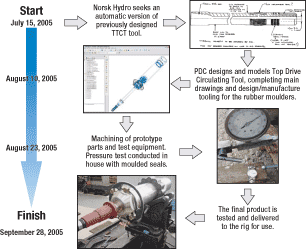 |
Fig. 1. The total time to develop the TDCT tool was just over six weeks.
|
|
The TDCT is a pump-out tool developed to save time in through-tubing rotary drilling operations by eliminating the need to repeatedly connect the top drive to, and detach it from, the drillstring. The tool makes up onto the top drive saver sub, and its telescopic stinger stabs into the box connection of the pipe while in the slips on the rotary table. The stinger hydraulically seals into the tool joint bore when landed, allowing the mud pumps to be switched on for circulation without the need to mechanically make up the pipe to the top drive.
Originally, the tool consisted of an outwardly sprung telescopic stringer. In this design, the tool stayed at its maximum length until installed into the drill pipe. It would then adjust for the air gap between the saver sub and the top of the box, due to the length of the bales and the pickup on the elevators. The tool, in this form had been successfully used before its application in Norway.
However, after the operator approached the vendor to assist in its Njord development, a joint assessment concluded that the TDCT, as it existed, was not appropriate for handling the pipe in the slips or for the operator’s system for racking back pipe. Furthermore, the tool’s mechanical return spring was found to be inadequate for this well.
To overcome these shortcomings, the vendor designed a modified version of the TDCT incorporating pneumatics. A joint risk assessment recommended a number of design changes:
- The tool must be rated to 5,000 psi and will be operated with rig air (90–100 psi).
- The tool must be fully retracted when lowering the travelling block.
- There must be a minimum gap of 6 in. between the bottom of the pump-out tool and the top of the WT-31 drill pipe box, when the elevator is closed and engaged on the drill pipe tool joint load shoulder.
- The travelling block/pump-out tool must be as close to the well center as possible to minimize misalignment. The gap between the tool bottom and drill pipe box helps to accommodate some degree of misalignment.
- To prevent unintentional mud spill, by the time the pump-out tool lands out on the WT-31 box, the set of seals must be positioned in the pipe body below the tool joint, to seal with a gap in the tool’s upper chamber, to allow mud flow through the tool.
- The pressure provided by rig air to the chamber must be sufficient to fully retract the tool, once the mud pumps are switched off.
- The seals are tested for wear reliability to provide indications of replacement frequency.
- The tools must be field-serviceable to a practical degree, like replacement of the cup seals and centralizer at the bottom of the telescopic shaft.
Within a few weeks, the vendor designed and manufactured a prototype TDCT, Fig. 2. The main feature is the pneumatically controlled telescopic stinger to ensure accurate seal placement. Once the tool is made up to the top drive saver sub, it automatically operates without the driller having to manipulate additional controls when the pumps are switched on and off, and the pipe picks up out of the slips. Included in the tool’s design is a unique internal check valve, which prevents mud spillage when engaging and disengaging the drillpipe.
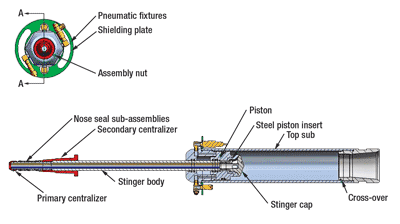 |
Fig. 2. Schematic of the TDCT, showing the telescopic stinger.
|
|
A series of cup seals at the end of the stinger ensure pressure integrity and seal in the box connection bore, to allow circulation through the drill pipe. Designing and proving the seals to 5,000 psi, and the ability for the tool to withstand pump rates up to 750 gpm, were part of the program. The trial provided the confidence to pursue this design to the next stage. The feedback was largely positive, with recommendations for minor design changes. Recommendations from the rig were reviewed, and final design changes were agreed between Norsk Hydro, KCA-Deutag and Pilot Drilling Control.
TOOL OPERATION
With the TDCT connected directly to the top drive and to the rig’s compressed air supply through to the lower chamber, both the annular piston and stinger shaft are forced by the air to move toward the top of the chamber, Fig. 3. The piston divides the chamber into two compartments. The area on the piston’s lower side is subjected to air pressure, and the upper side is exposed to the mud’s full force when the pumps are switched on. When this happens, the mud overcomes the air supply, forcing the piston to travel back down. As the piston reaches its travel limit, the stinger separates from the piston as it lands into the tool joint; appropriate spacing is required to ensure this. At the top of the stinger, the valve ports are exposed to allow the mud to pass down through the stinger and into the drill pipe. The mud cannot circulate without first landing the stinger, and the mud pressurizes the seals in the bore below the tool joint’s threaded section. When circulation is no longer required, the pumps are switched off, and the tool automatically seals the mud internally and retracts, ready for its next use.
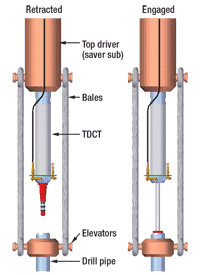 |
Fig. 3. Stages of operation include: 1) Extension; 2) Engagement and Circulation; and 3) Retraction.
|
|
The field version of the TDCT was manufactured and sent to the rig in time for the second well’s final preparation phase. The tripping out procedure was changed to accommodate the use of the TDCT. Table 1 shows the total tripping time on two subsea TTRD wells—one without any pump-out tool and the other with—including a column normalizing the data (tripping time per 1,000 m). This is only an attempt to present comparison data fairly, since tripping depth varies between wells and even on the same well.
| TABLE 1. Tripping performance. |
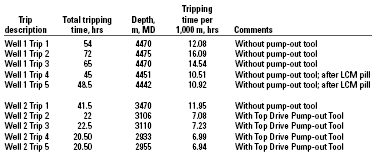 |
|
EXPERIENCE WITH THE TDCT
There were initial problems in using the TDCT by the rig crew, because of a lack of understanding of the tool’s operating principle and design limits. Problems in this area were minor and did not significantly affect tripping performance, as indicated by Table 1 and Fig. 4.
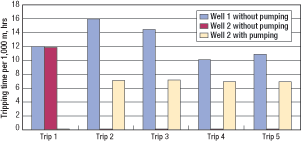 |
Fig. 4. Comparison chart shows improvement in tripping times with the new tool.
|
|
On the first well (Well 1), the kick-off point was below the existing perforation. The perforated zone was significantly depleted (about 4,350-psi depletion) and had been subjected to cycles of “huff and puff” (cycles of pressurization followed by production). Although the depleted zone was re-pressurized to reduce depletion to about 1,500 psi at the start of window milling, severe problems were experienced with wellbore breathing, making pumping out of hole an operational and safety necessity.
After milling the window, the depleted perforated zone was treated with an LCM pill, which reduced the rate of losses into the formation while pumping out of hole. The benefit can be seen in the improved tripping times for trips 4 and 5, compared to earlier trips on Well 1. However, the true value of the TDCT was demonstrated on the second well, where tripping times were just about half the tripping time per 1,000 m recorded on Well 1. On Well 2, normal tripping was undertaken pumping out of hole with a comparable tripping time per 1,000 m, demonstrating a consistent level of operational and crew performance.
On subsequent trips (trips 2 to 5) on the same well, tripping times were significantly reduced. There was evidence of increasing tripping efficiency as the rig crew’s familiarity with the TDCT increased. Unfortunately, the tool was damaged beyond any repair the rig crew could undertake. The damage was due to inexperience by a new crew that had just arrived and was unfamiliar with the tool’s operation. Subsequent tripping out of the well saw times comparable to earlier tripping times without the pump-out tool, demonstrating beyond any doubt the economic benefit of the TDCT to the operations.
The incident demonstrated the mistake in not having a backup tool on the rig or in the workshop. This risk was considered at the risk assessment stage, and it was decided that only one piece of the tool would be ordered, since it was impossible to anticipate the significant, positive benefit on the rig’s tripping times during the design and planning stage. The tool performance exceeded the operator’s expectations. Its loss once again doubled tripping times and, by extension, increased the well construction cost. Fortunately, within the space of a week, the tool was repaired and sent back out to the rig to continue operations. During this time, new parts were made, and the tool was modified to limit the extent of future possible damage.
FUTURE IMPROVEMENTS
The tool’s success on Well 2 before the damage makes it impossible to consider drilling future TTRD wells without a TDCT, in circumstances where pumping out of hole is a prerequisite for operational or safety reasons. Its success also exposed some design limitations to be incorporated into future tools.
The TDC pump-out tool was purpose-built and designed to meet very restrictive design criteria stipulated in the statement of requirements. These requirements, however, did not consider the pipe’s condition over the life cycle. The TDCT sent to the rig was designed to function with a new WT-31 drill pipe connection. There was an occasion when a problem occurred with sealing in a drill pipe box. The thread had been re-cut, and the gap between the top of the drill pipe box and the bottom of the tool attached to the top drive was outside the gap stipulated in the design criteria.
Therefore, with the tool fully retracted, the top part of the retractable stinger could not land out on the WT-31 box. Consequently, the fail-safe feature built into the tool design would not allow pumping through the tool (valve now fully closed). This was not a major issue, as it only occurred once. But the probability would have increased with the passage of time, and with the pipe used for a longer period and on other wells. Modifying the tool to allow for a longer floating stinger (while still retaining the set of seals) that accommodates the wear and re-cut of the drill pipe connection in use may provide a more adaptive solutions for variations in tool joint connections’ conditions, Fig. 5.
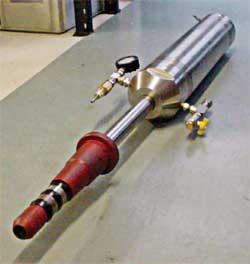 |
Fig. 5. The tool�s design will be modified further, based on initial field performance
|
|
The loss of the tool and subsequent loss of tripping time could have been avoided, if the stinger was made replaceable. This would have negated the need to send the tool back to the workshop for repairs. Enhancing the tool further with a modular-design stinger assembly would also reduce installation cost to operators, to fit different connection types. The most important benefit of a modular design is that it will allow the rig crew to replace the stinger, in the event of damage experienced with complete loss of the tool’s performance benefits.
CONCLUSION
The TDCT performance exceeded project expectations. The efficiency gains made on the second well made the TDCT an indispensable tool for future TTRD projects, where pumping operations are a necessary requirement. The efficiency gains attributable to the TDCT will be enhanced by modifications and design adjustments based on field operations, as described in this article. 
|
THE AUTHORS
|
|
George Swietlik is managing director of Pilot Drilling Control Ltd., based in Suffolk, England, UK. He started in the oil and gas industry in 1972, after completing a mechanical engineering degree at Salford University. He has worked in the industry ever since, gaining knowledge and experience within the drilling sector. In 1991, he formed Pilot Drilling Control Ltd to explore and develop innovative downhole drilling tools. In 1997 the company moved to purpose-built facilities in Lowestoft, UK, to expand its proto-typing/ manufacturing capability to international drilling and completion service businesses.
|
|
 |
Joy Oyovwevotu earned a BSc degree in chemical engineering from the University of Lagos, Nigeria, in 1989 and an MBA degree from Aberdeen Business School, The Robert Gordon University, UK, in 2000. He has over 15 years of industry experience, joining Shell Nigeria in 1991 as a drilling engineer trainee. Mr. Oyovwevotu was transferred to Shell Expro UK in 1996, where he worked in a number of positions before returning to SPDC in 2000. He joined LEAding Edge Advantage (LEA) as a senior drilling engineer in 2001, working on advanced drilling technique projects with a special emphasis on Through Tubing Rotary Drilling.
|
|
|










